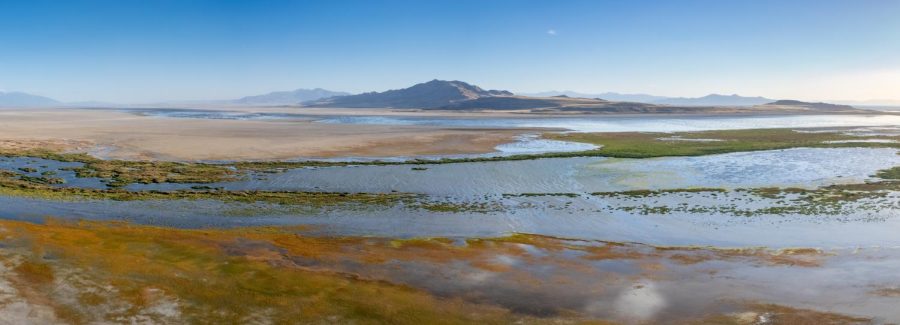U Professors Explain Why the Great Salt Lake is Shrinking
A flock of geese in the wetlands by the Antelope Island, Utah on Sept. 18, 2022. (Photo by Xiangyao “Axe” Tang | The Daily Utah Chronicle)
November 14, 2022
This year, the Great Salt Lake hit a record low level on July 3, when it reached a 4,109 feet, according to the Utah Division of Water Resources.
The Great Salt Lake is the largest saline lake in the Western Hemisphere and the eighth largest in the world. The lake, because of its warm waters, causes frequent lake-effect snowfall in the Wasatch Mountains, contributing 5-8% of the snowpack. It also supports mining of magnesium and sulfate of potash and allows for a large brine shrimp industry.
According to Kevin Perry, a University of Utah professor of atmospheric sciences, the lake level is controlled by how much water flows into it and how much water is evaporating, as the lake does not have an outlet to the ocean. Perry explained the lake is at such low levels for two reasons: diverting water that normally flows into the lake and the drought that Utah has been experiencing for many years.
“We’ve been diverting way too much water from the streams that feed the Great Salt Lake for other purposes,” Perry said. “There was a study done at Utah State [University] that determined that the lake is about 70 feet lower than its natural elevation, and they attributed 11 feet of that decrease to water diversion and about six feet due to our ongoing megadrought.”
Because of these two factors, Perry said about 800 square miles of the lake bed have been exposed.
“When the water recedes it leaves kind of a salt and mineral crust on the surface,” Perry said. “But the longer that’s exposed, the more it starts to erode.”

Bill Johnson, a professor of geology and geophysics, explained that many toxic trace elements are deposited at the bottom of the lake because water only gets out through evaporation.
“It has a geochemistry that supports tying up these trace elements in complexes with compounds such as sulfide,” Johnson said. “These types of trace elements can combine with sulfide to form minerals that sediment out and end up on the bottom of a lake.”
Johnson noted a concern from the public is the potentiality of the dust being raised by wind events.
“Yes, [it] certainly [could], but a lot more has to be understood to know what kind of hazard it presents because we also need to understand how easily dissolved or solubilized these trace elements are inside say, for example, your lungs,” Johnson said.
According to the New York Times, the lake bed also contains high levels of arsenic that wind storms could carry into the lungs of nearby residents as the lake bed becomes more exposed.
Perry said that 9% of the exposed lake bed is currently acting as a dust source for the surrounding areas.
“And when those dust plumes move into the surrounding communities, it significantly reduces the visibility,” Perry said.
Perry said particles that are 2.5 to 10 micrometers big are the particles that actually get into ones lungs when they breathe.
“What they’ve determined is that when those concentrations of PM 10 or PM 2.5 are high enough, it doesn’t matter what the particles are made out of — they pose a health hazard,” Perry said.
As the lake is at its lowest level, Perry said mitigation tactics have been taken and proposed in order to help the lake and the surrounding area including some kind of drip irrigation system, but they’re complicated processes.
“Do we set up some kind of drip irrigation system with brine where we armor those soil [and] those vulnerable areas with a cross derived from the evaporation of the brine itself?” Johnson asked. “But that becomes another water balance issue.”
Perry spoke optimistically about the current steps being taken by the Utah State Legislature to mitigate the shrinking lake. HB 410, put forth by Brad Wilson, speaker of the Utah House of Representatives, seeks to improve and protect the Great Salt Lake watershed.
“They made more substantive legal changes to water law that have ever been made in the history of Utah [by] trying to level the playing field so that more water could eventually end up in the Great Salt Lake,” Perry said.
Perry acknowledged there’s still a lot of work that needs to be done, but the raised awareness in the state in the last few years has significantly changed his outlook.
“The people of Utah have started to notice the environmental impacts of the shrinking lake,” Perry said. “They’ve gotten concerned about it, and they reached out to the legislators and have expressed those concerns and the legislature has actually responded.”









